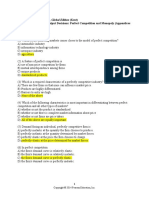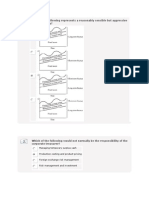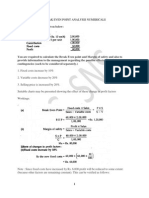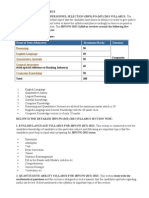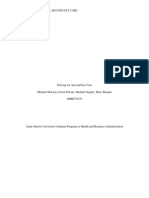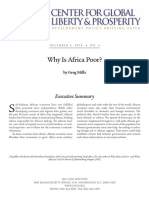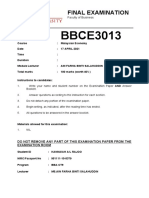Development & Growth
Development & Growth
Uploaded by
Sachin SahooCopyright:
Available Formats
Development & Growth
Development & Growth
Uploaded by
Sachin SahooOriginal Description:
Copyright
Available Formats
Share this document
Did you find this document useful?
Is this content inappropriate?
Copyright:
Available Formats
Development & Growth
Development & Growth
Uploaded by
Sachin SahooCopyright:
Available Formats
Chapter 43 - Economic Growth and Development
Chapter 43 Economic Growth and Development
Multiple Choice Questions 1. A country's Real GDP can increase for brief periods of time A. Only if its aggregate demand increases B. Only if its aggregate supply increases C. If either its aggregate demand or its aggregate supply increases D. Only if both its aggregate demand and its aggregate supply increases
2. In order for a country's Real GDP to increase without inflation or deflation over long periods time A. Its aggregate demand must increase B. Its aggregate supply must increase C. Either its aggregate demand or its aggregate supply must increase D. Both its aggregate demand and its aggregate supply must increase
3. The U.S. represents less than 5% of the world's population, but produces a share of the world's output almost equal to A. 5% B. 10% C. 25% D. 50%
4. Expected deflation can reduce Aggregate Demand by A. Reducing the purchasing power of money B. Reducing the willingness to purchase big-ticket items C. Increasing nominal interest rates D. Reducing the government's budget deficit
43-1
Chapter 43 - Economic Growth and Development
5. Aggregate Demand is increased by A. Increased interest rates B. Increased taxes C. A stronger currency D. Increased consumer confidence
6. Aggregate Demand is reduced by A. Increased government spending B. Increased interest rates C. Reduced taxes D. A stronger dollar
7. As Real GDP increases, ceteris paribus, the slope of the Aggregate Supply curve A. Increases B. Remains unchanged C. Decreases D. Is always zero
8. Aggregate Supply can always be increased as workers A. Work smarter, better and more efficiently B. Work harder C. Are provided with better education, tools, and technology D. Both A and C
9. Aggregate Supply increases when A. Raw materials prices rise B. Government regulations proliferate C. Wages rise D. Wages fall
43-2
Chapter 43 - Economic Growth and Development
10. Aggregate Supply decreases when A. Worker productivity increases B. Raw materials prices fall C. Technology improves D. Wages rise
11. The ultimate source of long-term growth in already developed countries is A. Increased worker productivity B. Larger and more powerful government C. A workforce that always works harder D. Unrestricted immigration
12. From 1990 to 2004, developed countries that experienced larger increases in Real GDP tended also to experience higher rates of A. Population growth B. Deflation C. Unemployment D. Productivity growth
13. From 1990 to 2004 among developed countries, a 1 percentage point increase in productivity growth was associated with increased per capita GDP growth of A. 0.01% B. 0.30% C. 1.50% D. 3.00%
14. Increases in worker productivity usually reflect A. Increased education and improved equipment B. Management that pushes workers to work longer and harder C. Elimination of unemployment benefit programs D. Growth of labor unions
43-3
Chapter 43 - Economic Growth and Development
15. Increases in worker productivity usually reflect policies that encourage A. Population growth B. Consumption C. Investment in physical and human capital D. Extensive government regulation of business
16. Investment in physical and human capital is typically encouraged by A. Lower taxes on interest income B. Lower taxes on investment returns C. Lower taxes on returns to education D. All of the above
17. Sustainable economic growth depends upon A. Investment, not saving B. Saving, not investment C. Both saving and investment D. Neither saving nor investment
18. The greatest threat to continued growth in the developed countries might be A. Low interest rates B. Low inflation rates C. Moderate marginal tax rates D. Restrictive regulatory policies
19. Among countries with Per Capita GDP in 2004 less than $2,000, A. The Gini coefficient of income inequality tends to be lower B. The consumer price inflation rate tends to be lower C. Agriculture tends to produce a larger share of GDP D. High-income households tend to consume a smaller share of GDP
43-4
Chapter 43 - Economic Growth and Development
20. Among countries with Per Capita GDP in 2004 less than $2,000, A. High-income households tend to consume a larger share of GDP B. The consumer price inflation rate tends to be lower C. Agriculture tends to produce a smaller share of GDP D. All of the above
21. Among countries with Per Capita GDP in 2004 greater than $20,000, A. High-income households tend to consume a larger share of GDP B. The consumer price inflation rate tends to be higher C. The Heritage Foundation Index tends to show more economic freedom D. Agriculture tends to produce a larger share of GDP
22. Overall income disparity can be measured by A. The difference between GDP and GNI B. The Gini Index C. The growth rate in Real GDP D. The population growth rate
23. Without adjusting for "purchasing power parity", Real GDP tends to understate income in developing economies by A. Underestimating saving B. Ignoring government deficit spending C. Omitting non-market transactions D. All of the above
24. In developing economies, the fraction of the economy in non-market transactions can be as much as A. 10 percent B. 25 percent C. 50 percent D. 75 percent
43-5
Chapter 43 - Economic Growth and Development
25. Using the cost of a similar market basket of goods across countries to compare an economic variable like Gross National Income applies the concept of A. Private equity financing B. The Heritage Foundation Index of Economic Freedom C. The Gini Index D. Purchasing power parity
26. The Solow Growth Model predicts that A. Rich nations will grow faster than poor nations B. The rich will get richer and the poor will get poorer C. The rich will get poorer and the poor will get richer D. Poor nations will grow faster than rich nations
27. If the central prediction of the Solow Growth Model is valid, A. Per capita Real GDP differences among nations will increase B. Per capita Real GDP differences among nations will diminish C. Economic freedom as measured by the Heritage Foundation Index will decrease D. Population growth rates in rich countries will increase
28. Among countries with Per Capita GDP in 2004 greater than $20,000, A. The political structure tends to be relatively democratic B. Tax rates tend to be extremely high C. Environmental regulations tend to be extremely repressive D. All of the above
29. Among countries with Per Capita GDP in 2004 less than $2,000, A. The political system tends to be undemocratic B. The banking system tends to be unsound C. The government tends to be relatively corrupt D. All of the above
43-6
Chapter 43 - Economic Growth and Development
30. Low wages and low-cost land in developing countries will not attract foreign investment in manufacturing facilities if the developing countries A. Permit unrestricted repatriation of profits B. Protect their central banks from political control C. Lack well-developed infrastructure D. All of the above
31. Among countries with Per Capita GDP in 2004 less than $2,000, A. Inflation rates tend to be high B. Central banks tend to be weak or non-existent C. The ruling party typically can print money when it wants D. All of the above
32. Among countries with Per Capita GDP in 2004 less than $2,000, the opportunity cost of increased education and literacy for young workers might be measured as A. New palaces and more soldiers for the ruling party B. Increased consumption among the educated elites C. Increased investment in improved infrastructure D. Shortages of food or health care for the poor
33. Since the 1960s, some of the best examples of transition from developing to developed economies can be found in A. East Asia B. West Asia C. Western Europe D. North America
34. Since the 1960s, development coincided with political liberalization in A. China B. South Korea C. North Korea D. Saudi Arabia
43-7
Chapter 43 - Economic Growth and Development
35. Since the 1960s, development proceeded without many natural resources in A. Canada B. Saudi Arabia C. Japan D. All of the above
36. Refer to Figure 43.1. The increase in Real GDP might reflect A. Increased marginal tax rates on capital income B. Increased raw materials prices C. Increased education among workers D. Increased standards of environmental protection
37. Refer to Figure 43.1. The increase in Real GDP might reflect A. Lower marginal tax rates on capital income B. Increased current government spending C. Increased consumer confidence D. Increased standards of environmental protection
43-8
Chapter 43 - Economic Growth and Development
38. Refer to Figure 43.1. If Aggregate Demand does not change, the increase in Real GDP will be accompanied by A. A higher price level B. No change in the price level C. A lower price level D. Lower real wages
39. Refer to Figure 43.1. The increase in Real GDP might reflect A. Increased consumer confidence B. Increased current government spending C. A weaker currency D. Increased worker productivity
40. Refer to Figure 43.1. The increase in Real GDP is unlikely to A. Result from capital accumulation B. Occur repeatedly in the future C. Occur in developed economies D. Result from a better-educated workforce
43-9
You might also like
- Wilfrid Laurier University: EC260 - Intermediate Microeconomic Analysis For ManagementDocument11 pagesWilfrid Laurier University: EC260 - Intermediate Microeconomic Analysis For Managementlana del reyNo ratings yet
- CH 06Document22 pagesCH 06Kreatif TuisyenNo ratings yet
- Exercise Module 2Document7 pagesExercise Module 2AríesNo ratings yet
- Survey of Economics 8th Edition Tucker Test BankDocument30 pagesSurvey of Economics 8th Edition Tucker Test BanklindsaycoopergiabxnfmqsNo ratings yet
- International Economics, 7e (Husted/Melvin) Chapter 3 The Classical Model of International TradeDocument25 pagesInternational Economics, 7e (Husted/Melvin) Chapter 3 The Classical Model of International TradeAli AlshehhiNo ratings yet
- Exercise Chapter 07Document15 pagesExercise Chapter 07Azaan KaulNo ratings yet
- Chapter 06 - Behind The Supply CurveDocument90 pagesChapter 06 - Behind The Supply CurveJuana Miguens RodriguezNo ratings yet
- Homework of Chapter 25 Production and GrowthDocument5 pagesHomework of Chapter 25 Production and GrowthMunkh-Erdene OtgonboldNo ratings yet
- Exam#1 (1) SolutionDocument6 pagesExam#1 (1) SolutionaininhusninaNo ratings yet
- Examen Ener 2016 (Ing) ADocument4 pagesExamen Ener 2016 (Ing) AManuel GranadosNo ratings yet
- Chapter 8 - Ge Managerial EconomicsDocument11 pagesChapter 8 - Ge Managerial EconomicssaadNo ratings yet
- Chapter 2 The One Lesson of BusinessDocument11 pagesChapter 2 The One Lesson of BusinessMai PhamNo ratings yet
- Froeb 01Document13 pagesFroeb 01textbookhkNo ratings yet
- Internship Report IIUCDocument69 pagesInternship Report IIUCMM. Hasan100% (1)
- Mlis Research ProposalDocument12 pagesMlis Research Proposalapi-138018801No ratings yet
- Ryerson University Department of Economics ECN 204 Midterm Winter 2013Document22 pagesRyerson University Department of Economics ECN 204 Midterm Winter 2013creepyslimeNo ratings yet
- Econ 601 f14 Midterm Answer Key PDFDocument5 pagesEcon 601 f14 Midterm Answer Key PDFюрий локтионовNo ratings yet
- Chap005 ASBE 6e IMDocument16 pagesChap005 ASBE 6e IMAmarjeet SinghNo ratings yet
- Chapter 05 - QuizDocument13 pagesChapter 05 - QuizSonNam Vu Le33% (3)
- Chapter1 2Document6 pagesChapter1 2Young Joo MoonNo ratings yet
- Chapter 1: Economics For Managers (Question Bank & Answers)Document13 pagesChapter 1: Economics For Managers (Question Bank & Answers)tk_atiqah100% (1)
- Acc 255 Final Exam Review Packet (New Material)Document6 pagesAcc 255 Final Exam Review Packet (New Material)Tajalli FatimaNo ratings yet
- Answer KeyDocument46 pagesAnswer KeyNHI NGUYỄN KHẢNo ratings yet
- 1 Economics October 2013 PRTCDocument8 pages1 Economics October 2013 PRTCCharry RamosNo ratings yet
- Answer Key To Problem Set 4Document11 pagesAnswer Key To Problem Set 4ryohazuki76No ratings yet
- Chap 007Document55 pagesChap 007Joy-mileny Sepulveda100% (2)
- Test Bank 2Document6 pagesTest Bank 2Nouran BakerNo ratings yet
- Quiz 2Document4 pagesQuiz 2LNo ratings yet
- Econ Quiz 6 With AnswersDocument3 pagesEcon Quiz 6 With AnswersGielarmi Julie RequinaNo ratings yet
- Chapter 03Document80 pagesChapter 03raiNo ratings yet
- CHAPTER 4 Economic151 Sample TestDocument13 pagesCHAPTER 4 Economic151 Sample TestDiem Suong100% (1)
- Macroeconomics Assignment-1Document2 pagesMacroeconomics Assignment-1Beza GetachewNo ratings yet
- ECN204 Final 2011FDocument13 pagesECN204 Final 2011Fexamkiller100% (1)
- Measuring A Nation'S Income: Questions For ReviewDocument4 pagesMeasuring A Nation'S Income: Questions For ReviewNoman MustafaNo ratings yet
- PigouDocument3 pagesPigouvikram inamdarNo ratings yet
- Fin 455 Fall 2017 FinalDocument10 pagesFin 455 Fall 2017 FinaldasfNo ratings yet
- MCQ FinanceDocument5 pagesMCQ FinancebusinessmbaNo ratings yet
- Case 12.1Document3 pagesCase 12.1MandaviNo ratings yet
- Questions For Practicing With KeyDocument35 pagesQuestions For Practicing With Keydenglijun1712No ratings yet
- Supply and DemandDocument3 pagesSupply and DemandKeira TanNo ratings yet
- Market FailureDocument4 pagesMarket Failurebhaskarbora@live.comNo ratings yet
- Essential of Finance Corporate Chapter 3Document12 pagesEssential of Finance Corporate Chapter 3Linas Sutkaitis100% (1)
- CH 2Document11 pagesCH 2ceojiNo ratings yet
- ECON 102 Midterm 2012W2Document7 pagesECON 102 Midterm 2012W2examkillerNo ratings yet
- Chapter 24 Measuring The Cost of Living: Multiple ChoiceDocument9 pagesChapter 24 Measuring The Cost of Living: Multiple ChoiceBùi Thu TrangNo ratings yet
- Practice Test 4-5Document16 pagesPractice Test 4-5Nguyễn Thị Hồng YếnNo ratings yet
- MCQ 6 EditedDocument41 pagesMCQ 6 EditedAamir SohelNo ratings yet
- Assignment 1 (PPC)Document2 pagesAssignment 1 (PPC)hhsdramalreedNo ratings yet
- Test 2 Sample MCQ (4-8)Document13 pagesTest 2 Sample MCQ (4-8)gg ggNo ratings yet
- Indirect Labor Is Not A Component of Manufacturing OverheadDocument5 pagesIndirect Labor Is Not A Component of Manufacturing OverheadAmol Kothawade100% (1)
- Chap 20 Test Bank Test BankDocument41 pagesChap 20 Test Bank Test BankVũ Hồng PhươngNo ratings yet
- Chapter 06 Test BankDocument61 pagesChapter 06 Test BankMariamNo ratings yet
- Problems: Set B: InstructionsDocument2 pagesProblems: Set B: InstructionsflrnciairnNo ratings yet
- Chapter 23 QuizDocument15 pagesChapter 23 QuizRhobie CuaresmaNo ratings yet
- Chapter 11Document158 pagesChapter 11nikowawa100% (1)
- STM Test BankDocument4 pagesSTM Test BankMelese ewnetie100% (1)
- Chapter 19Document17 pagesChapter 19Summer VongNo ratings yet
- Unit 1: Resources in An EconomyDocument62 pagesUnit 1: Resources in An EconomySalmanyousafbandeshaNo ratings yet
- Chapter 11 Reporting and Analyzing The Statement of Cash Flows PDFDocument66 pagesChapter 11 Reporting and Analyzing The Statement of Cash Flows PDFDyenNo ratings yet
- Financial Instruments and Institutions: Accounting and Disclosure RulesFrom EverandFinancial Instruments and Institutions: Accounting and Disclosure RulesNo ratings yet
- ECN204 Midterm 2014WDocument12 pagesECN204 Midterm 2014WexamkillerNo ratings yet
- Econ MidtermsDocument22 pagesEcon Midtermskarasukitsune123No ratings yet
- Important Committees On Banking in IndiaDocument4 pagesImportant Committees On Banking in IndiaSachin SahooNo ratings yet
- Break Even Point Analysis NumericalsDocument7 pagesBreak Even Point Analysis NumericalsSachin SahooNo ratings yet
- Engineering Economics & Costing AssignmnetDocument1 pageEngineering Economics & Costing AssignmnetSachin SahooNo ratings yet
- Asian Development BankDocument13 pagesAsian Development BankSachin SahooNo ratings yet
- Ugc Net EconomicsDocument17 pagesUgc Net EconomicsSachin SahooNo ratings yet
- EtcDocument3 pagesEtcSachin SahooNo ratings yet
- IBPS PO SyllabusDocument2 pagesIBPS PO SyllabusSachin SahooNo ratings yet
- Shortcut To Find Cuberoot of Any 5 or 6 Digit NumberDocument14 pagesShortcut To Find Cuberoot of Any 5 or 6 Digit NumberSachin SahooNo ratings yet
- IsoquantsDocument2 pagesIsoquantsSachin SahooNo ratings yet
- GA Questions - IBPS RRB Office Assitant Exam 28:sept:2014 (Morning Shift) General Awareness QuestionsDocument6 pagesGA Questions - IBPS RRB Office Assitant Exam 28:sept:2014 (Morning Shift) General Awareness QuestionsSachin SahooNo ratings yet
- General Awareness Questions: GA Questions Asked in IBPS RRB Exam - 21th Sept-2014 (Morning Shift)Document2 pagesGeneral Awareness Questions: GA Questions Asked in IBPS RRB Exam - 21th Sept-2014 (Morning Shift)Sachin SahooNo ratings yet
- 42the SI Exam for Letter & Application-2025Document20 pages42the SI Exam for Letter & Application-2025sadirh37No ratings yet
- Studying Financial Inclusion in North-East IndiaDocument53 pagesStudying Financial Inclusion in North-East IndiaBasavaraj MtNo ratings yet
- Africa and The Successor GenerationDocument270 pagesAfrica and The Successor Generationalkhwarizmi1968100% (1)
- CutlDocument36 pagesCutlapi-3211097980% (1)
- Melc 2 Applied EconomicsDocument5 pagesMelc 2 Applied EconomicsCLARISE LAURELNo ratings yet
- B. Alive Four Men Injured D. Injured Four Alive Men D. by and byDocument9 pagesB. Alive Four Men Injured D. Injured Four Alive Men D. by and byName UserNo ratings yet
- Budgeting: Purpose of A Budget Preparing Your BudgetDocument3 pagesBudgeting: Purpose of A Budget Preparing Your BudgetiskandarmalaysiaNo ratings yet
- End of Term Report of The 31st UP Student RegentDocument8 pagesEnd of Term Report of The 31st UP Student RegentKrista MelgarejoNo ratings yet
- Global Road Safety For Children: Safe Roads - Safe KidsDocument28 pagesGlobal Road Safety For Children: Safe Roads - Safe KidsOur Lady of Mt. Carmel Parish PBSMBNo ratings yet
- Solving For Aravind Eye CareDocument11 pagesSolving For Aravind Eye CarekavitaNo ratings yet
- Poverty, Inequality and Development by Custodio, Niña Gabrielle & Alcantara, Jairus AlbertDocument9 pagesPoverty, Inequality and Development by Custodio, Niña Gabrielle & Alcantara, Jairus AlbertGabrielle CustodioNo ratings yet
- Health Care Reform in EthiopiaDocument13 pagesHealth Care Reform in Ethiopiaamanuelwondimagegn5No ratings yet
- FieldDocument24 pagesFieldElias100% (2)
- Chirenje Tourism Leakages Nyanga PDFDocument8 pagesChirenje Tourism Leakages Nyanga PDFkudaNo ratings yet
- SDG 1 No PovertyDocument10 pagesSDG 1 No PovertySnigdha KamraNo ratings yet
- Survey Question Street VendorDocument6 pagesSurvey Question Street VendorRedgielyn EcalnirNo ratings yet
- International Examples of Affordable Housing - Shelter URBED TrustDocument19 pagesInternational Examples of Affordable Housing - Shelter URBED TrustAkshata ChauguleNo ratings yet
- 4EC1 02R Rms 20190822Document22 pages4EC1 02R Rms 20190822Adeeba iqbalNo ratings yet
- CIIF-CFC21CallforProposalsENGLISH 1 3 ID55493Document18 pagesCIIF-CFC21CallforProposalsENGLISH 1 3 ID55493Shema MayanjaNo ratings yet
- Why Africa Is Poor PDFDocument8 pagesWhy Africa Is Poor PDFEvah Boemo MosetlhaneNo ratings yet
- Reproductive Health Bill: Facts, Fallacies: First Posted 00:46:00 08/03/2008Document10 pagesReproductive Health Bill: Facts, Fallacies: First Posted 00:46:00 08/03/2008cyclone_ervineNo ratings yet
- Kenya WordDocument4 pagesKenya WordJanaky VasuNo ratings yet
- Women Industry and TechnologyDocument7 pagesWomen Industry and TechnologyJohn SmithNo ratings yet
- HRM627 Final Term 2010 S01Document102 pagesHRM627 Final Term 2010 S01tina kaifNo ratings yet
- Research Chapter 1 4ps PDFDocument7 pagesResearch Chapter 1 4ps PDFAbigail CachoNo ratings yet
- Más Allá de La Basura La Representación y La Voz Del Recolector Informal de Materiales Reciclables en Textos Escritos y Filmicos de Tres Paises SudamericanosDocument259 pagesMás Allá de La Basura La Representación y La Voz Del Recolector Informal de Materiales Reciclables en Textos Escritos y Filmicos de Tres Paises SudamericanosLeila GiovanaNo ratings yet
- 2015 Grade 8 English Model ExamDocument10 pages2015 Grade 8 English Model Exammuhmmd20140% (1)
- FE - 202101 - BBCE 3013 A QuestionDocument10 pagesFE - 202101 - BBCE 3013 A QuestionkannaiahNo ratings yet










